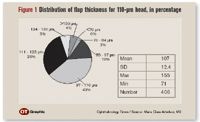Article
Thin-flap LASIK safe and predictable, study finds
Author(s):
Muscat, Sultanate of Oman-The Carriazo-Pendular microkeratome (Schwind eye-tech-solutions) has been shown to be safe and to produce flaps of predictable thickness with two different cutting head sizes and two different suction ring sizes in a large, multicenter European study.

Maria Clara Arbelaez, MD, Muscat Eye Laser Center, Muscat, Sultanate of Oman, plus Rainer Wiltfang, MD, and Martin Bechmann, MD, Smile Eyes Laser Eye Clinic, Munich, Germany, conducted a study in which they performed 1,354 LASIK procedures using the microkeratome to create the flaps.
In this study, the 110- and 130-µm heads were used. Data were analyzed based on the choice of the suction rings, 9 or 10 mm. A total of 667 eyes underwent LASIK at the Smile Eyes clinic, and 687 eyes were treated at the Muscat Eye Laser Center.
All eyes in the study were healthy and had not previously undergone a refractive procedure. The preoperative corneal thicknesses ranged from 500 to 679 µm. Patients with K-readings ranging from 38.88 to 48.32 D were treated. One blade was used to make one cut. The corneal thickness was measured with ultrasound pachymeter before and during the procedure; the difference between the two was taken as the flap thickness.
When the investigators combined the data from both surgical sites, they found that in the 406 eyes treated with the 110-µm head, the mean flap thickness was 107 ± 12.4 µm (range, 71 to 155 µm). In the 948 eyes treated with the 130-µm head, the mean flap thickness was 128 ± 13.9 µm (range, 86 to 171 µm) (See Figures 1 and 2.)
Commenting on these results, Dr. Arbelaez said, "With the 130-µm head, we achieved an 83% probability that the mean flap thicknesses using the two suction rings are identical. With the 110-µm head, we achieved a 91% probability that the mean flap thicknesses using the two suction rings are identical. This shows that the choice of suction ring does not affect the mean flap thickness."
The investigators found a significant correlation (p < 0.01) between the preoperative corneal thickness and the corneal flap thickness. The slopes of the trend lines for both heads were 0.13 (parallel trend lines), meaning that for each 100-µm change in the preoperative corneal thickness, the flap thickness changed by 13 µm.

A significant correlation (p < 0.01) also was observed between the average K-reading and the corneal flap thickness.
Newsletter
Don’t miss out—get Ophthalmology Times updates on the latest clinical advancements and expert interviews, straight to your inbox.




